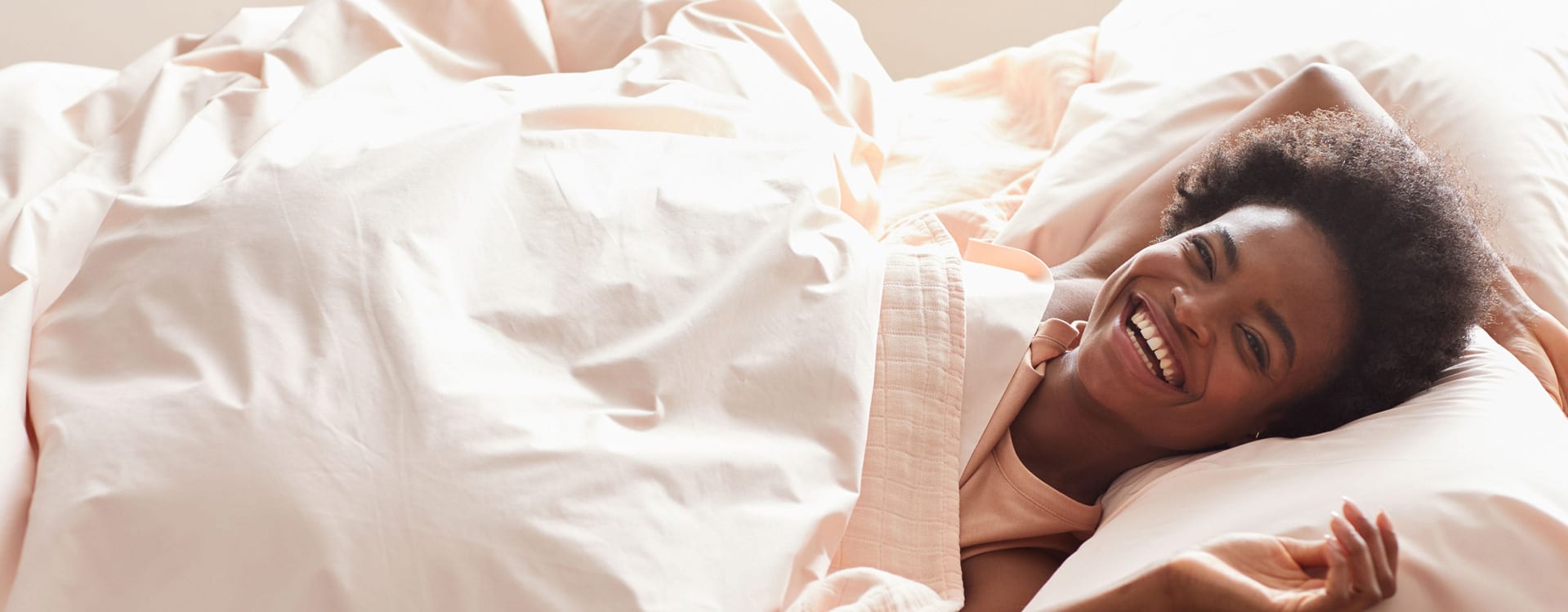We offer down and down alternative duvet inserts. RDS-certified down is a favorite choice for premium bedding, but our synthetic down alternatives are also hypoallergenic and equally lofty—an excellent option for those with sensitivities to down, or who prefer down-free bedding.
Pairing a duvet insert with a duvet cover creates one of our favorite bedding options: a two-piece top layer that’s equally suitable for an elegant main bedroom or a playful kids’ room. Explore our comprehensive guide to learn the benefits of duvets and find tips for choosing a duvet insert and cover for optimal comfort.
Benefits: Duvets vs. Comforters
Although they are similar top bedding layers—both are down or down alternative-filled shells made with durable fabric—the main difference between a duvet and a comforter is how each piece is used. Comforters stand alone, while duvet inserts are intended to be paired with a cover. As a result, comforters often feature decorative or colored shells, while duvets are typically white. Additional benefits of a duvet include:
- Washability: A duvet cover protects an insert from spills, soil, and stains, and is easier to wash than bulky inserts or comforters.
- Personalization: Duvet inserts are available in a range of weights, warmth levels, and fills, making it easy to personalize your bedding to suit your sleeping preferences.
- Versatility: If you’re prone to changing your mind or prefer to update your bedding with the seasons, you’ll love the versatility afforded by duvet covers. They can be changed as frequently as you’d like and require minimal storage space.
- Ease of Use: A duvet cover renders a top sheet unnecessary, making a duvet-and-cover pairing a popular option for those who dread making the bed—especially kids.
Things to Consider When Choosing a Duvet Insert
Choosing a duvet insert is similar to choosing a comforter. You’ll need to consider the shell, the fill, and the construction to decide which duvet insert is best for you.
Our down and down alternative duvet inserts are available in a range of warmth levels to suit the season and your individual sleeping preferences.
- The best duvet inserts for warm weather are the same as those that suit hot sleepers—opt for extra-light or light inserts.
- For year-round comfort, we recommend a medium-warm duvet insert.
- For cold temperatures and cold sleepers, an extra- or ultra-warm insert keeps you cozy.
- Partners who prefer different sleeping temperatures can customize their comfort with a dual-weight duvet insert.
The fill power of down in a duvet insert measures the amount of air an ounce of down can trap, and therefore its insulating ability. Higher fill powers offer more warmth for the same weight, creating a lightweight but warm duvet. We offer duvet inserts with fill powers between 500 and 700 for the perfect balance of weight and warmth.
Our duvet insert shells are tightly woven from soft, durable, breathable cotton and are often plain white, although some feature subtle jacquard or damask patterns for added elegance. Thread count is an important indicator of a well-made duvet insert—the higher the thread count, the more tightly woven the fabric and the better its ability to keep down clusters contained.
Look for duvet inserts boasting baffle box or sewn-through box constructions to ensure the down doesn’t shift or bunch. Which is best is a matter of personal preference. Baffle-box duvet inserts feature internal fabric walls that separate the top and bottom layers of fabric to offer exceptional loft and distribution of fill, while sewn-through construction provides a pillowy aesthetic.
Duvet inserts coordinate with standard mattress sizes, from Twin to California King. We also offer oversized duvet inserts for Queen and King beds. Sized slightly wider than their respective covers, these inserts create an ultra-lofty, extra-sumptuous look for your bed without extra weight or warmth.
How to Choose a Duvet Cover
A duvet cover is a protective and decorative layer that slips around a duvet insert or comforter like a pillowcase. Ours feature corner ties to attach easily to the insert’s loops—preventing shifting and bunching—and a buttonhole closure along the bottom edge. Duvet covers come in a range of colors, fabric choices, and designs to suit your preferences. Choose a duvet cover that matches the size of your insert.

Styling Tip: Want a fluffy look? Try stuffing your duvet cover with two inserts instead of one. Another option is to use a smaller sized duvet cover with a larger comforter (for example, a king size comforter with a queen size duvet cover).
Choose the Right Duvet Cover Fabric
When choosing a duvet cover, consider which fabric best suits your preferences. Thread count affects the warmth of woven fabrics—higher thread counts mean tighter weaves for warmer bedding—but it isn’t the only thing to look for—flannel is measured in ounces up to the warmest 6-ounce option, and jersey knit is not woven, so there’s no thread count. Explore our Sheet Guide to learn more about each fabric option.
- Cotton Percale – Crisp, cool to the touch
- Linen – Airy, moisture-wicking
- TENCEL™ Lyocell – Lightweight and breathable
- Jersey Knit – Breathable yet warm
- Cotton Sateen – Heavy, warm, buttery soft
- Flannel – Warm and cozy, fuzzy, super soft
We take great care in crafting high-quality bedding that meets standards of ethical and environmental responsibility. If you’re looking for an eco-friendly duvet cover option, consider organic cotton or sustainable TENCEL™ Lyocell.
Coordinate Your Duvet Cover With Sheets and Other Bedding

Whether your bed is the focal point of your room or you prefer to let your decorative accents shine, a duvet cover should coordinate with the other elements in your space. Our duvet covers are sold individually and in sets with matching pillow shams—choose from versatile neutrals, vibrant solids, elegant patterns, and seasonal designs—so you can create a cohesive bedding look or mix and match layers to your heart’s content.
Choosing a duvet cover or insert is as simple as selecting any other bedding—once you know what to look for. For more bedding tips and tricks, explore our Inspiration Guide.
